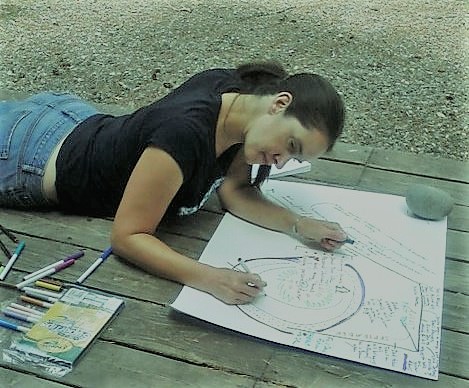Ergonomics: design factors, as for the workplace, intended to maximize productivity by minimizing operator fatigue and discomfort. (dictionary.com)
On my way to work this morning, ice crunching under foot, feeling sore from last night’s yoga class, it occurred to me that I underestimate the power the body holds over creativity. Considering I’m a yoga teacher, this seemed to me to be a pretty serious oversight. Of course, I know that body and mind are indisputably connected to each other and that the joining of the body and mind, as in yoga, leads to greater freedom and happiness. So, what’s the oversight? The fact that in order to walk the path to greater freedom and happiness, one must take strides, each stride represented by an aspect of life that you open to yoga. This thought led me to thinking about the ergonomics of writing and how so much of what I think is writer’s block or fatigue, is really just failure to bring my body with me to the “writing desk”, or rather that a writer can be more productive if they forgo the desk altogether and let the world be their desk. So, here are some tips that I’ve come up with as I mull this one over that perhaps can help you and me write more and more often.
1. Use props: For Christmas I got this lap desk, with a wood-hatch storage that also works to prop up books and lap and wrist foam padding. Love it! I use it in bed, on the couch, sitting cross-legged on the floor. I just had no idea. No more trying to prop books and papers up with my hands and elbows. No more disappearing laps. I also sometimes use one of those props for papers while you type. I like mouse pads with gel wrist support and ones that run along the front of the keyboard. Some of those even come filled with aromatic herbs for inspiration. Find the props that work for you and feel free on any given day to use or not use these props. Your body will tell you what you need. Don’t mistake this for writer’s block. Rearrange and prop up and then get back to the task at hand. Put your feet up. Sit cross-legged. Dictate your ideas while walking.
2. Write everywhere, everyway: When I’m working on a major project, I print hard copies and keep them in hard cover 3-ring binders. Sometimes, I edit or add sitting at my computer or laptop, sometimes, take that binder and write in the back yard, on a park bench, at a café, or half way through a walk with the dog. Stay flexible. If your body is telling you that it doesn’t want to sit in a straight backed chair in front of your computer, try something else, anything (suspended upside down from the ceiling?) until the writing comes.
Interested in hiring me as a coach to get you boosted with your writing goals?
Find free resources and information here.
Some past posts to keep you making time:
Adjust your pace accordingly.
It’s about the routine and how you shake up the routine
There are things you will have to give up
See it to achieve it
Washing the dishes
Write slowly
A celebration of the pause
Monday, a run through the driving rain
Zen accident
Get out of your comfort zone


When I was about 9 years old my dad made my mom a reading platform that she could use while bathing in the tub. I used it myself as I was quite a prolific reader at that age. In Hawaii back when laptops were not generally available to the general public, I bought and used an electronic type writer. Basically it was a word processor with a 4 line screen. I used that battery operated unit at the beach to write many times.